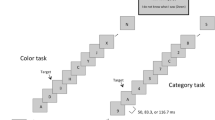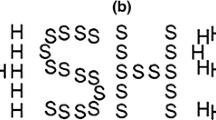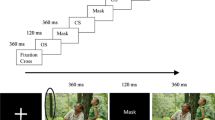Abstract
The findings are evidence that persons with ASD benefit more than typically developing (TD) persons from spatial framing cues in focusing their attention on a visual target. Participants were administered a forced-choice task to assess visual filtering. A target stimulus was presented on a screen and flanker stimuli were presented simultaneously with or after the target, with varying stimuli onset asynchronies (SOAs). Regardless of SOA, TD children showed the expected distracting effects with slower reaction times (RTs) when flankers were at closer distances from the target. However, children with ASD displayed shorter RTs in the conditions in which the stimuli were presented simultaneously or with a short SOA. These findings are interpreted as reflecting utilitarian attention among children with ASD.





Similar content being viewed by others

Notes
An a priori power analysis based on Cohen’s moderate effect size (.25) for the interaction effects suggests that a total N of 24 would be needed for a power of .80. In addition, a post hoc power analysis for detection of the interaction effect, using our estimates of effect size from the data, revealed a power estimate of .86 (minimum is .80). Given our interest in the interaction effects with group, these estimates suggest that the number of participants allows for the detection of an appropriate effect size.
Differences between distractor types were not analyzed as part of the primary analyses because we had no specific hypotheses related to distractor type, effects of type were controlled with the experiment design, and sample size did not warrant the inclusion of another independent variable. However, an exploratory analysis of distractor type revealed that all patterns described in the primary analyses held, and that the magnitude of these effects was in general greater when the distractors were dissimilar than when they were similar. In addition, this difference was more pronounced for the TD group than the ASD group. These effects need to be explored further in future studies.
References
American Psychiatric Association. (2000). Diagnostic and statistical manual of mental disorders (4th ed.). Washington, DC: American Psychiatric Association.
Bowler, D. (2006). Autism spectrum disorders: Psychological theory and research. West Sussex: Wiley.
Brodeur, D. A. (2004). Age changes in attention control: Assessing the role of stimulus contingencies. Cognitive Development, 19, 241–252. https://doi.org/10.1016/j.cogdev.2004.01.002.
Burack, J. A. (1994). Selective attention deficits in persons with autism: Preliminary evidence of an inefficient attentional lens. Journal of Abnormal Psychology, 103, 535–543. https://doi.org/10.1037/0021-843X.103.3.535.
Burack, J. A., Iarocci, G., Flanagan, T., & Bowler, D. M. (2004). On melting pots and mosaics: Conceptual considerations for matching strategies. Journal of Autism and Developmental Disorders, 34, 65–73. https://doi.org/10.1023/B:JADD.0000018076.90715.00.
Burack, J. A., Jefferies, L. N., Ringo, J., & Landry, O. (2017). Attention. In B. Hopkins, E. Geangu & S. Linkenauger (Eds.), Cambridge encyclopedia of child development. Cambridge: Cambridge University Press.
Burack, J. A., Russo, N., Koshoff, H., Fernandes, T. P., Ringo, J., Landry, O., & Iarocci, G. (2016). How I attend—not how well do I attend: Rethinking developmental frameworks of attention and cognition in autism spectrum disorder and typical development. Journal of Cognition and Development, 17(4), 553–567
Cedrus Corporation (2005). SuperLab Pro (Version 4.0). San Pedro, CA: Cedrus Corporation.
Eriksen, B. A., & Eriksen, C. W. (1974). Effects of noise letters upon the identification of a target letter in a nonsearch task. Perception and Psychophysics, 16, 143–149. https://doi.org/10.3758/BF03203267.
Gaspelin, N., Ruthruff, E., & Lien, M. C. (2016). The problem of latent attentional capture: Easy visual search conceals capture by task-irrelevant abrupt onsets. Journal of Experimental Psychology: Human Perception and Performance, 42, 1104–1120. https://doi.org/10.1037/xhp0000214.
Greenaway, R., & Plaisted, K. (2005). Top-down attentional modulation in autistic spectrum disorders is stimulus-specific. Psychological Science, 16, 987–994. https://doi.org/10.1111/j.1467-9280.2005.01648.x.
Iarocci, G., Burack, J. A., Shore, D. I., Mottron, L., & Enns, J. T. (2006). Global-local visual processing in high functioning children with autism: Structural versus implicit task biases. Journal of Autism and Developmental Disorders, 36, 117–129.
Jonides, J., & Yantis, S. (1988). Uniqueness of abrupt visual onset in capturing attention. Perception & Psychophysics, 43, 346–354. https://doi.org/10.3758/BF03208805.
Keehn, B., & Joseph, R. M. (2008). Impaired prioritization of novel onset stimuli in autism spectrum disorder. Journal of Child Psychology and Psychiatry, 49, 1296–1303. https://doi.org/10.1111/j.1469-7610.2008.01937.x.
Landry, R., & Bryson, S. E. (2004). Impaired disengagement of attention in young children with autism. Journal of Child Psychology and Psychiatry, 45, 1115–1122. https://doi.org/10.1111/j.1469-7610.2004.00304.x.
Mann, T. A., & Walker, P. (2003). Autism and a deficit in broadening the spread of visual attention. Journal of Child Psychology and Psychiatry, 44, 274–284. https://doi.org/10.1111/1469-7610.00120.
Rincover, A., & Ducharme, J. M. (1987). Variables influencing stimulus overselectivity and “tunnel vision” in developmentally delayed children. American Journal of Mental Deficiency, 91, 442–430.
Ristic, J., & Enns, J. T. (2015a). Attentional development: Past, present, and future. In L. Liben & U. Mueller (Eds.), Handbook of child psychology: Cognitive processes within the relational, developmental system (2, 7th ed.). Hoboken, NJ: Wiley-Blackwell.
Ristic, J., & Enns, J. T. (2015b). The changing face of attentional development. Current Directions in Psychological Science, 24, 24–31.
Ristic, J., Mottron, L., Friesen, C. K., Iarocci, G., Burack, J. A., & Kingstone, A. (2005). Eyes are special but not for everyone: The case of autism. Cognitive Brain Research, 24, 715–718.
Robertson, C. E., Kravitz, D. J., Freyberg, J., Baron-Cohen, S., & Baker, C. I. (2013). Tunnel vision: Sharper gradient o spatial attention in autism. Journal of Neuroscience, 33, 6776–6781. https://doi.org/10.1523/JNEUROSCI.5120-12.2013.
Roid, G., & Miller, L. (1997). Leiter International Performance Scale- Revised. Wood Dale, IL: Stoelting.
Ronconi, L., Gori, S., Ruffino, M., Molteni, M., & Facoetti, A. (2013). Zoom-out attentional impairment in children with autism spectrum disorder. Cortex, 49, 1025–1033. https://doi.org/10.1016/j.cortex.2012.03.005.
Schneider, W., Eschman, A., & Zuccoloto, A. (2007). E-prime 2.0. Pittsburgh: Psychological Software Inc.
Schreij, D., Owens, C., & Theeuwes, J. (2008). Abrupt onsets capture attention independent of top-down control settings. Perception & Psychophysics, 70, 208–218. https://doi.org/10.3758/PP.70.2.208.
Townsend, J., & Courchesne, E. (1994). Parietal damage and narrow “spotlight” spatial attention. Journal of Cognitive Neuroscience, 6, 220–232. https://doi.org/10.1162/jocn.1994.6.3.220.
Townsend, J., Courchesne, E., & Egaas, B. (1996). Slowed orienting of covert visual-spatial attention in autism: Specific deficits associated with cerebellar and parietal abnormality. Development and Psychopathology, 8, 563–584. https://doi.org/10.1017/S0954579400007276.
von Mühlenen, A., Rempel, M. I., & Enns, J. T. (2005). Unique temporal change is the key to attentional capture. Psychological Science, 16, 979–986. https://doi.org/10.1111/j.1467-9280.2005.01647.x.
Wainwright-Sharp, J. A., & Bryson, S. E. (1993). Visual orienting deficits in high-functioning people with autism. Journal of Autism and Developmental Disorders, 23, 1–13. https://doi.org/10.1007/BF01066415.
Yantis, S., & Jonides, J. (1984). Abrupt visual onsets and selective attention: Evidence from visual search. Journal of Experimental Psychology: Human Perception and Performance, 10, 601–621. https://doi.org/10.1037/0096-1523.10.5.601.
Acknowledgments
The authors gratefully acknowledge the children and parents who participated in our project, the teachers and staff from Summit and Giant Steps schools in Montreal, Heidi Flores, Stephanie Rishikof, Vanessa Babineau, and members of the McGill Youth Study Team who helped with data collection, and Margarita Miseros, Emily Stubbert, and Samantha O’Brien for their help in the preparation of the manuscript. This work was funded by a grant from the Social Sciences and Humanities Research Council of Canada awarded to Jacob A. Burack.
Funding
This study was funded by the Social Sciences and Humanities Research Council of Canada (File Number 410-2009-1144).
Author information
Authors and Affiliations
Contributions
All authors contributed to the study concept and design. DAB and TD developed the stimuli and task design. JS and TD recruited participants and collected study data. Study data was analyzed by DAB and JS. The study manuscript was prepared by DAB, JS, and JAB. All authors read and approved the final manuscript.
Corresponding author
Ethics declarations
Conflict of interest
D.A. Brodeur declares that she has no conflict of interest. J. Stewart declares that she has no conflict of interest. T. Dawkins declares that she has no conflict of interest. J. A. Burack declares that he has no conflict of interest.
Ethical approval
All procedures performed in this study were in accordance with the ethical standards of the institutional and/or national research committee and with the 1964 Helsinki declaration and its later amendments or comparable ethical standards. Informed consent was obtained from parents or guardians of all individual participants included in the study.
Rights and permissions
About this article
Cite this article
Brodeur, D.A., Stewart, J., Dawkins, T. et al. Utilitarian Attention by Children with Autism Spectrum Disorder on a Filtering Task. J Autism Dev Disord 48, 4019–4027 (2018). https://doi.org/10.1007/s10803-018-3619-5
Published:
Issue Date:
DOI: https://doi.org/10.1007/s10803-018-3619-5



